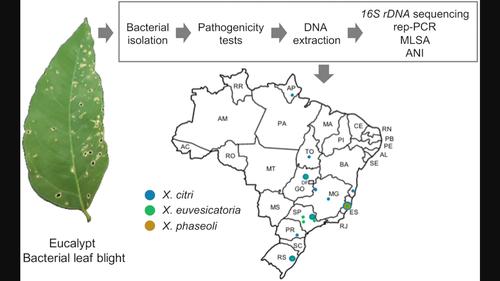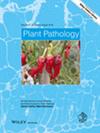Xanthomonas species causing leaf blight on eucalypt plants in Brazil and transfer of Xanthomonas axonopodis pv. eucalyptorum to Xanthomonas citri pv. eucalyptorum comb. nov.
IF 2.4
3区 农林科学
Q1 AGRONOMY
引用次数: 0
Abstract
Outbreaks of bacterial leaf blight (BLB) frequently affect eucalypt plants under nursery and field conditions in several countries. Although research has been conducted to unveil the causal agent, different bacterial species have been associated with similar disease symptoms in different countries. In order to determine the causal agent of BLB in Brazil, a survey was conducted in nine states to recover bacterial isolates from eucalypt plants exhibiting typical BLB symptoms. A total of 41 yellow-colony isolates with varying aggressiveness towards a susceptible eucalypt clone were obtained, with 16S rDNA sequences indicating that they belong to the Xanthomonas genus. Rep-PCR analysis separated the Xanthomonas population affecting eucalypt into six distinct groups revealing its high genetic diversity. The same population formed three clusters together with reference strains of X. citri, X. euvesicatoria and X. phaseoli in a phylogenetic tree constructed with partial dnaK, fyuA, gyrB and rpoD gene sequences. Clustering in the phylogenetic tree was clearly related to grouping based on rep-PCR. Genome sequence comparisons of representative eucalypt isolates with type strains of validly published Xanthomonas species confirmed that the population consisted of X. citri, X. euvesicatoria and X. phaseoli. Inoculation of tomato, common bean, castor bean and eucalypt plants showed that the representative eucalypt isolates can cause disease in these plant species. Based on the results, the transfer of Xanthomonas axonopodis pv. eucalyptorum to Xanthomonas citri is proposed. These results are relevant for eucalypt BLB management under nursery and field conditions, including selection and deployment of effective plant resistance.

引起巴西桉树叶枯病的黄单胞菌种类及桉树黄单胞菌 pv. eucalyptorum 向柠檬黄单胞菌 pv. eucalyptorum comb.
在一些国家的苗圃和田间条件下,细菌性叶枯病(BLB)经常影响桉树植物。虽然已经开展了揭示病原体的研究,但在不同国家,不同的细菌种类与类似的疾病症状有关。为了确定巴西 BLB 的病原菌,我们在九个州进行了一项调查,从表现出典型 BLB 症状的桉树植物中提取细菌分离物。共获得 41 个黄单胞菌分离株,它们对易感桉树克隆的侵染性各不相同,16S rDNA 序列表明它们属于黄单胞菌属。Rep-PCR 分析将影响桉树的黄单胞菌种群分为六个不同的群组,揭示了其高度的遗传多样性。在利用部分 dnaK、fyuA、gyrB 和 rpoD 基因序列构建的系统发生树中,同一种群与参考菌株柠檬黄单胞菌(X. citri)、优维西卡托菌(X. euvesicatoria)和相叶黄单胞菌(X. phaseoli)形成了三个群。系统发生树中的聚类与基于 rep-PCR 的分组明显相关。将代表性桉树分离株的基因组序列与有效公布的黄单胞菌种类的模式菌株进行比较,证实该种群由柠檬黄单胞菌(X. citri)、欧维西卡氏黄单胞菌(X. euvesicatoria)和相叶黄单胞菌(X. phaseoli)组成。对番茄、四季豆、蓖麻和桉树植株的接种表明,具有代表性的桉树分离株可在这些植物物种中致病。根据这些结果,提出了桉树黄单胞菌 pv. Xanthomonas axonopodis pv. eucalyptorum 向柠檬黄单胞菌转移的可能性。这些结果与苗圃和田间条件下的桉树BLB管理有关,包括选择和部署有效的植物抗性。
本文章由计算机程序翻译,如有差异,请以英文原文为准。
求助全文
约1分钟内获得全文
求助全文
来源期刊

Plant Pathology
生物-农艺学
CiteScore
5.60
自引率
7.40%
发文量
147
审稿时长
3 months
期刊介绍:
This international journal, owned and edited by the British Society for Plant Pathology, covers all aspects of plant pathology and reaches subscribers in 80 countries. Top quality original research papers and critical reviews from around the world cover: diseases of temperate and tropical plants caused by fungi, bacteria, viruses, phytoplasmas and nematodes; physiological, biochemical, molecular, ecological, genetic and economic aspects of plant pathology; disease epidemiology and modelling; disease appraisal and crop loss assessment; and plant disease control and disease-related crop management.
 求助内容:
求助内容: 应助结果提醒方式:
应助结果提醒方式:


